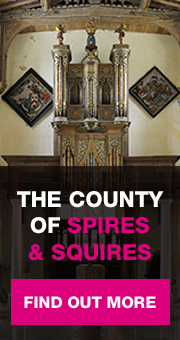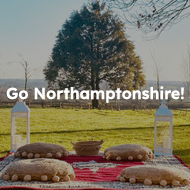Churches for a purpose:
-
Top PickAll Saints and Saint James Church stands on an imposing site with the east wall of the chancel facing Hall Yard. The present rectory is a fine Georgian building which was formerly a mill...
-
Top PickWhilst the tower is medieval the church was so re built in the 17th and 18th century and that is it’s overriding appearance. The vestry though was added by Bodley, 1879. Internally...
-
Top PickNow re-opened following extensive Roof Repair & Restoration works. For centuries this was an estate church to a succession of families, the Burnabys, Clerkes, and then the Edens, later...
-
This archetypal medieval church is set in the heart of the village. It abuts a clearly later square tower (1633) topped by a good spire and on the south side a chapel, refashioned in 1621...
-
A 14th/15th century building with very good furnishings. 15th century Rood Screen and pews,17th century three decker pulpit, 18th century box pews. The stained glass dates from the mid...
-
St Mary the Virgin is a fine, 13th Century Grade I listed mediaeval Northamptonshire ironstone and limestone church with a spectacular tower and broach spire. Under the direction of Sir...
-
The village of Barnwell has two churches. The parish church of St Andrews and the remains of All Saints. The latter was largely demolished in 1825 but its chancel was maintained as it had...
-
This sumptuous tractarian church was erected in 1848 through the munificence of the Watts-Russell family. it was designed by John Macduff Derick and was further enhanced by Sir Ninian Comper...
-
This pleasantly remote church stands at the end of a short walk shaded by ancient trees, with the vestiges of the 18th century mansion of the O’Brien family to your left. Beyond its...
-
A 13th century church considerably extended in the 14th century in the perpendicular style. Restored in 1870 by Slater and Carpenter with pew ends carved by the then incumbent, the Revd...
-
Sitting on top of the hill, just across the road from Canons Ashby House, this church is also looked after by the National Trust. It is a fragment of the west end of the nave of the Augustinian...
-
The Church which lies adjacent to the House but which it antedates by some 400 years. It must have been used by the Bishops of Coventry whose seat this was before the advent of the Comptons...
-
One of the finest medieval churches in the county, off the main road and adjacent to the mainly 17th century Manor House. Elements of an earlier church can be discovered but the...
-
The tall Saxon tower is the oldest part of this church, which was rebuilt in the 16th century and then again, rather enthusiastically, in the mid 19th century. The latter was undertaken...
-
Originally a Norman church (west door) with a wide tall chancel added in 1338 when a college here was founded by John Giffard, Canon of York. It seems to have been the largest private...
-
Externally a particularly handsome medieval church with full square tower with fine double bell openings – all dating from circa 1300. The interior therefore comes as a surprise being...
-
St Andrew’s Church dates from the time of King Henry II (1154 -89). Its Norman arcade and additions from every subsequent medieval century, give this church a rich and varied history...
-
The remarkable feature of this church is the series of 14th century wall paintings which were discovered almost a century ago by Professor Ernest Tristram, the authority on such works and...
-
A quintessential country church standing alongside the village street from where you can look out across countryside that rolls away to the southern county border. Whilst the exterior...
-
Like the Royal Mausoleum at Frogmore St Peter’s is a magnificent mid 19th century memorial church: here to the memory of that famous Crimean soldier General James Brudenell, 7th Earl...
-
The building is early 14th century with a slightly later tower and then restored by Lord Alwyne Compton who on this occasion employed William Slater. Having visited Castle Ashby Lord Alwyne...
-
A large grand church set in the heart of this village positioned on a knoll. Before rushing inside stray around the back, as here you will not only get a very good view, but also encounter...
-
Evergreen Art Café is all about great coffee and fine art! We have created a unique concept that combines a fine art gallery space with a fantastic café area. So why not join...
-
The setting of the church, a little way from the village, remains untouched by the 20th and 21st centuries. It is at the south end of the village adjacent to Eydon Hall, a Grade 1 neo-...
-
It will be primarily the late 19th century / 20th century stained glass that will draw you to this small medieval church at the centre of this handsome ironstone village. The church itself...
-
A Royal church with yet further royal associations: a very significant victim of the Dissolution of the Monasteries. The village, Manor, and church had been royal property since the Conquest...
-
An enchanting stone-built village set in beautiful countryside surrounding Boughton House, a stately home and estate of 11,000 acres that is one of the seats of the Duke of Buccleuch....
-
A royal village indelibly linked with Edward lV's Queen, Elizabeth Woodville and with Charles ll who gave this crown property to his natural son Henry FitzRoy, Duke of Grafton. In the...
-
A royal village indelibly linked with Edward lV‘s Queen, Elizabeth Woodville and with Charles ll, who gave this crown property to his natural son Henry FitzRoy, Duke of Grafton. ...
-
The church dates from circa 1300 but it is the intervention of the Spencer family of nearby Althorp that transform the Medieval building. Sir John Spencer (d. 1522) rebuilt the chancel...
-
A wonderful juxtaposition of medieval England and the advance of 19th century technology. This towered and spired church, built in both limestone and ironstone, lies adjacent to the great...
-
The medieval church has a fine west tower circa 1500. Internally restored by William Slater in 1859/60 (he was born in the village) and later the chancel more elaborately by F. Butler with...
-
The church owes its grandeur to the fact that the town was, and still is part of the Duchy of Lancaster. The fascinating ancillary buildings – Bede House, the college and the school...
-
The medieval church here was re built in 1874 for Richard Naylor to designs by J.K. Colling which resulted in the most lavish 19th century church interiors in Northamptonshire. The architect...
-
You can spot this church from miles away although it lies in the Cherwell Valley. Its spire, dating from circa 1370, is both the most beautiful and one of the tallest in the county (60...
-
Of early medieval origin but almost entirely rebuilt during 15th century and an especially fine example of Perpendicular architecture, most notably its splendid lantern tower. From the...
-
St Peters is on the highest point of the village believed to have been the site of worship since pagan times. The present building dates from 1100 and has been extended over the...
-
This fine church, set in the tiny hamlet of Passenham, dates back to the 13th /14th century but was largely rebuilt in the early 17th – upper stages of the tower, the nave roof, and...
-
This church has strong American associations as during the Second World War some 6,000 men and women of the 351st Heavy Bombardment Group Eight, United States Army Airforce, were stationed...
-
The medieval church was destroyed during the siege of Rockingham Castle in the civil war as was the village that then surrounded it. The present building is on the same site and largely...
-
There are two reasons for visiting Rothwell - The Church of the Holy Trinity and the Market House. The church was large, even in Norman times and grew from the 14th century onwards. It...
-
The 12th century church in the beautiful village of Spratton is so special because it represents transitional architecture between Romanesque and Norman styles. There is a fine effigy...
-
This particularly fine church was built during the first half of the 14th century and there have been little alterations since then. It gives a very good impression of English gothic architecture...
-
The decline in the parish population from the late medieval period led to the demolition of the early parish church in 1722. In its place a fine early Georgian church was erected to the...
-
A handsome, light and well-proportioned church built in local limestone. Constructed circa 1250 -1300 and very likely restored by E.W. Law (1850-1872) and again by J.C. Traylen (1890/1)...
-
The church, like the village is indelibly linked to the family of George Washington. Lawrence Washington bought the manor here in 1540 and this is where the family remained until 1659....
-
The Deli @ Castle Ashby is a family run, Artisan delicatessen. We are located in the rural shopping yard at Castle Ashby and specialise in providing locally sourced...
-
Externally it is the late 15th century tower that grabs one’s attention. It was built by Lord Lovel, Lord Chamberlain to Richard lll. It is by far and away one of the most impressive...
-
In the mid 18th century the medieval church was radically altered as it took on the mantle of the mausoleum of the Dukes of Montagu of nearby Boughton House. This had only slight effect...
-
The ancient village centre stands above the flood plain of the river Nene. This now lies at the far end of the village which grew considerably in the late 19th century when the local iron...
Your login details have been used by another user or machine. Login details can only be used once at any one time so you have therefore automatically been logged out. Please contact your sites administrator if you believe this other user or machine has unauthorised access.








